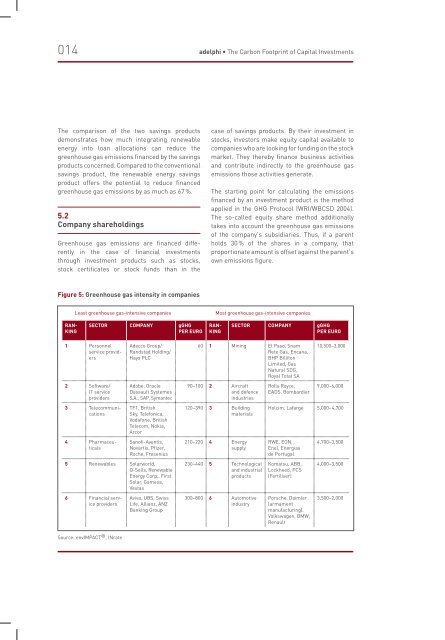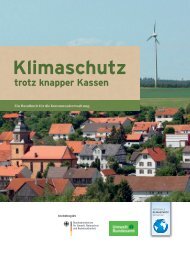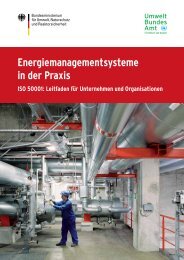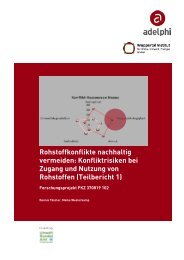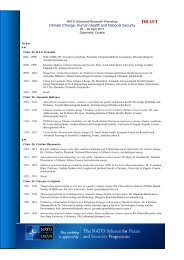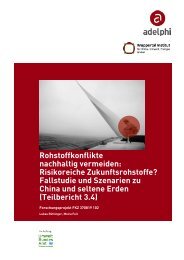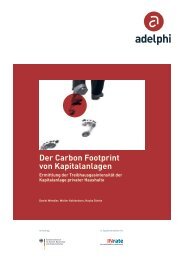The Carbon Footprint of Capital Investments - adelphi
The Carbon Footprint of Capital Investments - adelphi
The Carbon Footprint of Capital Investments - adelphi
Create successful ePaper yourself
Turn your PDF publications into a flip-book with our unique Google optimized e-Paper software.
014 <strong>adelphi</strong> • <strong>The</strong> <strong>Carbon</strong> <strong>Footprint</strong> <strong>of</strong> <strong>Capital</strong> <strong>Investments</strong> <strong>adelphi</strong> • <strong>The</strong> <strong>Carbon</strong> <strong>Footprint</strong> <strong>of</strong> <strong>Capital</strong> <strong>Investments</strong><br />
015<br />
<strong>The</strong> comparison <strong>of</strong> the two savings products<br />
demonstrates how much integrating renewable<br />
energy into loan allocations can reduce the<br />
greenhouse gas emissions financed by the savings<br />
products concerned. Compared to the conventional<br />
savings product, the renewable energy savings<br />
product <strong>of</strong>fers the potential to reduce financed<br />
greenhouse gas emissions by as much as 67 %.<br />
5.2<br />
Company shareholdings<br />
Greenhouse gas emissions are financed differently<br />
in the case <strong>of</strong> financial investments<br />
through investment products such as stocks,<br />
stock certificates or stock funds than in the<br />
Figure 5: Greenhouse gas intensity in companies<br />
Least greenhouse gas-intensive companies<br />
Sector Company gGHG<br />
per Euro<br />
1 Personnel<br />
service providers<br />
2 S<strong>of</strong>tware/<br />
IT service<br />
providers<br />
3 Telecommunications<br />
4 Pharmaceuticals<br />
Adecco Group/<br />
Randstad Holding/<br />
Hays PLC<br />
Adobe, Oracle<br />
Dassault Systemes<br />
S. A., SAP, Symantec<br />
TF1, British<br />
Sky, Telefonica,<br />
Vodafone, British<br />
Telecom, Nokia,<br />
Arcor<br />
San<strong>of</strong>i-Aventis,<br />
Novartis, Pfizer,<br />
Roche, Fresenius<br />
5 Renewables Solarworld,<br />
Q-Sells, Renewable<br />
Energy Corp., First<br />
Solar, Gamesa,<br />
Vestas<br />
6 Financial service<br />
providers<br />
Source: envIMPACT ® , INrate<br />
Aviva, UBS, Swiss<br />
Life, Allianz, ANZ<br />
Banking Group<br />
case <strong>of</strong> savings products. By their investment in<br />
stocks, investors make equity capital available to<br />
companies who are looking for funding on the stock<br />
market. <strong>The</strong>y thereby finance business activities<br />
and contribute indirectly to the greenhouse gas<br />
emissions those activities generate.<br />
<strong>The</strong> starting point for calculating the emissions<br />
financed by an investment product is the method<br />
applied in the GHG Protocol (WRI/WBCSD 2004).<br />
<strong>The</strong> so-called equity share method additionally<br />
takes into account the greenhouse gas emissions<br />
<strong>of</strong> the company's subsidiaries. Thus, if a parent<br />
holds 30 % <strong>of</strong> the shares in a company, that<br />
proportionate amount is <strong>of</strong>fset against the parent's<br />
own emissions figure.<br />
Most greenhouse gas-intensive companies<br />
<strong>The</strong> viewed renewable energy index tracks 30<br />
<strong>of</strong> the world's leading stock market quoted<br />
companies operating in the field. Those sectors<br />
are not the lowest-emission ones in terms <strong>of</strong> their<br />
greenhouse gas balance, but by concentrating on<br />
this sector the index does remain well below the<br />
emissions figures <strong>of</strong> the comparative indices. <strong>The</strong><br />
greenhouse gas intensity in this case is 165 gGHG<br />
per euro. <strong>The</strong> comparison <strong>of</strong> stock indices shows<br />
a clear correlation between the greenhouse gas<br />
intensity <strong>of</strong> the products and the incorporation <strong>of</strong><br />
climate protection aspects in their composition.<br />
While the greenhouse gas intensity <strong>of</strong> sustainabi-<br />
Ranking<br />
Ranking<br />
Sector Company gGHG<br />
per Euro<br />
60 1 Mining El Paso, Snam<br />
Rete Gas, Encana,<br />
BHP Billiton<br />
Limited, Gas<br />
Natural SDG,<br />
Royal Total SA<br />
90–100 2 Aircraft<br />
and defence<br />
industries<br />
120–390 3 Building<br />
materials<br />
210–220 4 Energy<br />
supply<br />
230–440 5 Technological<br />
and industrial<br />
products<br />
300–800 6 Automotive<br />
industry<br />
Rolls Royce,<br />
EADS, Bombardier<br />
10,500–3,000<br />
9,000–6,000<br />
Holcim, Lafarge 5,000– 4,700<br />
RWE, EON,<br />
Enel, Energias<br />
de Portugal<br />
Komatsu, ABB,<br />
Lockheed, PCS<br />
(Fertiliser)<br />
Porsche, Daimler<br />
(armament<br />
manufacturing),<br />
Volkswagen, BMW,<br />
Renault<br />
4,700–3,500<br />
4,000–3,500<br />
3,500–2,000<br />
INrate expanded this method to incorporate a<br />
financing component. Accordingly, the greenhouse<br />
gases financed by capital investments are not<br />
calculated proportionately to their percentage <strong>of</strong><br />
the total shares held in a company, but only to the<br />
extent to which shares contribute to the financing<br />
<strong>of</strong> the company by way <strong>of</strong> equity capital. This takes<br />
account <strong>of</strong> the fact that, by purchasing shares,<br />
investors increase the equity <strong>of</strong> the company<br />
the first time a dividend is paid on them. <strong>The</strong><br />
commercial activity <strong>of</strong> the company may, however,<br />
also be financed by borrowings. Based on this<br />
approach, therefore, only the proportion <strong>of</strong> the<br />
emissions <strong>of</strong> a company corresponding to the<br />
respective equity share is included in calculating<br />
the emissions financed by investors.<br />
<strong>The</strong> decisive factor in determining the greenhouse<br />
gas intensity <strong>of</strong> capital investment products, apart<br />
from the equity share, is the greenhouse gas<br />
intensity <strong>of</strong> the enterprises concerned. This varies<br />
very widely between different sectors (figure 5).<br />
Greenhouse gas-intensive companies emit up to<br />
175 times more greenhouse gases per euro earned<br />
than low-emission companies. Low greenhouse<br />
gas emission companies are mainly in the service<br />
sector. Renewable energy companies are "only" in<br />
fifth place, as no negative Scope 3 emissions are<br />
taken into account.<br />
5.2.1<br />
Stocks and stock certificates<br />
As there is no data relating to the overall portfolio<br />
composition <strong>of</strong> stock investments held by German<br />
private investors, the study instead utilised the<br />
composition <strong>of</strong> stock indices to calculate the<br />
emissions financed by capital investments in<br />
stocks and stock certificates. <strong>The</strong> indices mostly<br />
weight the companies according to the value <strong>of</strong><br />
their stock in circulation and their performance. 15<br />
<strong>The</strong>y thus provide a guide value – if a rough<br />
one – for the average investment behaviour on<br />
the stock market. <strong>The</strong> emissions financed by a<br />
capital investment in stocks or stock certificates<br />
are produced from the different weighting <strong>of</strong><br />
the companies in the respective index and their<br />
equity-financed greenhouse gas intensity. In this,<br />
a standard index is compared against a renewable<br />
energy index and two sustainability indices.<br />
<strong>The</strong> emissions financed by conventional investors<br />
are calculated by way <strong>of</strong> example based on a<br />
European standard index 16 . It maps the performance<br />
<strong>of</strong> the largest European blue-chips,<br />
representing a major portion <strong>of</strong> the total market<br />
capitalisation <strong>of</strong> all stock market quoted European<br />
companies. <strong>The</strong> calculations produce an emissions<br />
intensity for the index overall <strong>of</strong> 1,243 gGHG per<br />
euro.<br />
With regard to sustainability indices, two particularly<br />
market-relevant indices were applied<br />
as the calculation base. Both indices select only<br />
companies which have attained a certain minimum<br />
score in the underlying non-financial ratings. 17<br />
Climate aspects are covered by both ratings<br />
systems, but are weighted very differently. That is<br />
also reflected in the greenhouse gas intensities.<br />
<strong>The</strong> much less greenhouse gas-intensive index, at<br />
464 gGHG per euro, also imposes more stringent<br />
climate criteria than the much poorer-performing<br />
index, with emissions <strong>of</strong> 976 gGHG per euro. In<br />
this case, stricter criteria for non-financial ratings<br />
result in a lower greenhouse gas intensity <strong>of</strong> the<br />
indices. Both indices are, however, well below the<br />
greenhouse gas intensity <strong>of</strong> the standard index by<br />
comparison. <strong>The</strong>ir average weighted by investment<br />
volume is 632 gGHG per euro.<br />
15 <strong>The</strong><br />
composition <strong>of</strong> the individual indices is mostly based on different criteria. <strong>The</strong> two criteria cited are the ones most frequently used<br />
however.<br />
16 This index represents around 50 % <strong>of</strong> the free-float shares <strong>of</strong> European stock market listed companies.<br />
17 Sustainability<br />
indices in some cases pursue very different approaches with regard to the composition <strong>of</strong> their funds (see also Fowler,<br />
Stephen J. and Chris Hope 2007).


